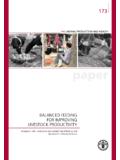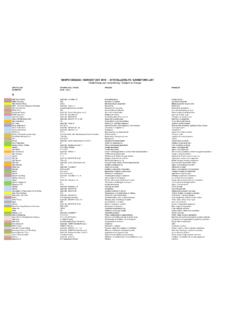Transcription of Cactus (Opuntia spp.) as forage
1 Cactus ( opuntia spp.) as forage 169 Food ,.. Org or -United N lon Cactus ( Opuntiaspp.) as forage Ed~ed by Candelario Mondragon-Jacobo lnstituto Nacional de Investigaciones Forestales y Agropecuarias (INIFAP) Mexico and Salvado r Perez-Gonzalez Universidad Aut6noma de Queretaro Mexico Coordinated for FAD by Enrique Arias Horticultural Crops Group Stephen G. Reynolds Grassland and Pasture Crops Group FAO Plant Production and Protection Division and Manuel D. sanchez Feed Resources Group FAO Animal Production and HeaHh Division Produced withi n the frameworl< of the FAO International Technical Cooperation Networl< on Cactus Pear FAO PLANT PRODUCTION AND PROTECTlON PAPER ot 169 unttttd NaUon Rome,2001 The designations employed and the presentation of material in thisinformation product do not imply the expression of any opinionwhatsoever on the part of the Food and Agriculture Organizationof the United Nations concerning the legal status of any country,territory, city or area or of its authorities, or concerning thedelimitation of its frontiers or rights reserved.
2 Reproduction and dissemination of material in thisinformation product for educational or other non-commercial purposes areauthorized without any prior written permission from the copyright holdersprovided the source is fully acknowledged. Reproduction of material in thisinformation product for resale or other commercial purposes is prohibited withoutwritten permission of the copyright holders. Applications for such permissionshould be addressed to the Chief, Publishing and Multimedia Service,Information Division, FAO, Viale delle Terme di Caracalla, 00100 Rome, Italy orby e-mail to 92-5-104705-7 FAO 2001 The designations developed and developing economies are intended for statisticalconvenience and do not necessarily express a judgement about the stage reached by aparticular country, country territory or area in the development views expressed herein are those of the authors and do not necessarily representthose of the Food and Agriculture Organization of the United Nations or of theiraffiliated organization(s).
3 Reprinted 2002iiiFOREWORDThe Cactus opuntia has been used in Mexico from pre-Hispanic times, and along with maize (Zea mays)and agave (Agavespp.), played a major role in the agricultural economy of the Aztec recent years there has been increased interest in opuntia species for the important role they play andare likely to play in the success of sustainable agricultural systems in marginal areas of arid and semi-arid are well-adapted to arid zones characterized by droughty conditions, erratic rainfall and poorsoils subject to erosion, having developed phenological, physiological and structural adaptations to sustaintheir development in these adverse environments. Notable adaptations are their asynchronousreproduction, and their Crassulacean Acid Metabolism, enabling them to grow with very high efficiencyunder conditions of limited opuntias may particularly contribute in times of drought, serving as a life saving crop to bothhumans and animals, they also regularly provide livestock forage in arid and semi-arid areas.
4 Theyprovide highly digestible energy, water and minerals, and when combined with a source of protein, theyconstitute a complete 1995 FAO published a book on Agro-ecology, cultivation and uses of Cactus pear, preparedthrough CACTUSNET, the international Cactus network, with only one chapter devoted to the use ofopuntia as feed. The present publication, also prepared through CACTUSNET, focuses primarily on theuse of opuntia as forage and presents many recent research and development preparation of this book was coordinated by Enrique Arias and Stephen Reynolds of the Horticultureand Grassland and the Pasture Crops Groups of the Plant Production and Protection Division, and byManuel Sanchez of the Feed Resources Group of the Animal Production and Health KuenemanChief, Crop and Grassland ServicePlant Production and Protection DivisionH.
5 KudoChief, Animal Production ServiceAnimal production and health divisionPREFACET owards the end of 1990, encouraged by the Mexican Embassy in Rome, a Mexican delegation consistingof researchers, technicians and officials from the federal agricultural sector, visited the island of Sicily, Italy,with the aim of initiating agreements to exchange information between the two countries concerning thecultivation and utilization of opuntia . When the delegation arrived on the island, the spectacular developmentof opuntia was noted. It was surprising to realize that formal cultivation of opuntia started only in the year later, an International Symposium on opuntia , with participants from Chile, Italy, Mexico andUSA, was organized in Lagos de Moreno (Jalisco, Mexico), with the purpose of encouraging producers andresearchers to increase cooperation among the participating countries and to diffuse information on theimportance of a follow-up to this meeting, it was proposed to create an International Technical Cooperation Networkon Cactus Pear (CACTUSNET).
6 The proposal was presented in a special session of the SecondInternational Congress on opuntia , which was held in Santiago, Chile, in 1992. CACTUSNET wasestablished under the auspices of the Food and Agriculture Organization of the United Nations (FAO) in aspecific meeting organized by the University of Guadalajara, Mexico, in August 1993, with the participationof ten countries from the Americas, Asia and Europe. Subsequently, several African countries have alsojoined the , thanks to the voluntary cooperation of CACTUSNET members residing in countries with anarid environment, it was possible to start a database on countries of production, opuntia uses, and cultivatedareas. At the end of the 20th century, the area under cultivated opuntia for forage was reported to be900 000 ha, greatly surpassing the reported area for fruit (100 000 ha).
7 For farmers in arid zones, opuntiaplanting is one solution to the problem of recurrent droughts. The succulence and nutritive value of opuntiamake it a valuable emergency crop, permitting livestock farmers in Brazil, Mexico, South Africa and USA tosurvive prolonged and severe is worth mentioning that most authors of this book are technicians and scientists with wide experience intheir own country of cultivation and use of opuntia as forage . The publication strengthens the writteninformation on opuntia , since most of the existing publications have emphasized its use as a , I would like to mention that the diffusion of information on species like opuntia can allow assessmentof its value for tackling drought in the short term, while in the medium term opuntia can constitute animportant alternative to counteract global climate change and desertification.
8 Other benefits from opuntiaare soil and water conservation, and protection of local fauna in arid and semi-arid publication of this book is, therefore, opportune, reflecting one of the basic objectives of the CACTUSNET,namely the diffusion of technical and scientific knowledge on opuntiaDr Eulogio PimientaUniversity of Guadalajara, MexicoFirst General Coordinator of the CACTUSNETvCONTENTSF orewordiiiPrefaceivAcknowledgementsxINTR ODUCTION 1 GENERAL BACKGROUND ON OPUNTIA1 BOTANY1 TERMINOLOGY2 CACTUSNET3 opuntia AS FORAGE3 ENVIRONMENTAL ISSUES4 PURPOSE OF THE BOOK4 HISTORY OF THE USE OF opuntia as forage IN MEXICO5 Marco Antonio AN AYA-P REZINTRODUCTION5 ORIGIN5 DISTRIBUTION6 COLONIAL MEXICO7 Description of the opuntia plant7 Propagation8 Livestock raising9 Forage9 INDEPENDENT MEXICO10 Livestock husbandry10 The forage10 RECENT DEVELOPMENT OF opuntia IN MEXICO11 Forage11 opuntia production12 ECOPHYSIOLOGY OFOPUNTIA FICUS-INDICA13 Park S.
9 NOBELINTRODUCTION13 DAILY GAS EXCHANGE13 WATER-USE EFFICIENCY14 WATER RELATIONS15 TEMPERATURE RELATIONS17 LIGHT RELATIONS17 NUTRIENT RELATIONS18 ATMOSPHERIC CO218 PREDICTED PRODUCTIVITIES18 COMPARISONS WITH OTHER SPECIES19 CONCLUSIONS20viGERMPLASM RESOURCES AND BREEDING OPUNTIA21 FOR FODDER PRODUCTIONC andelario MONDRAG N-JACOBO and Salvador P REZ-GONZ LEZINTRODUCTION21 BIOLOGICAL BASIS OF BREEDING22 opuntia BREEDING TECHNIQUES22 LIMITATIONS TO BREEDING23 GERMPLASM RESOURCES23 Wild stock23 Backyard sources24 EARLY ATTEMPTS AT BREEDING opuntia FOR FODDER24 The improved Mexican cultivars24 The Palmas of Brazil 25 The spineless Burbank selections in South Africa25 ACTIVE BREEDING PROGRAMMES25 BREEDING GOALS26 Cold Tolerance26 Spineless pads27 Plant productivity27 High protein content27 Pest and disease tolerance27 IMPROVED opuntia CULTIVARS BEYOND 200027 PRODUCTION AND USE OF opuntia AS FORAGE29IN NORTHERN MEXICOJuan Jos L PEZ-GARC A.
10 Jes s Manuel FUENTES-RODR GUEZand RODR GUEZOPUNTIA IN NORTHERN MEXICO29 GEOGRAPHICAL DISTRIBUTION OF NOPALERAS29 DISTRIBUTION OF THE MAIN forage SPECIES30 PRODUCTION31 Wild stands31 Cultivated nopaleras31 HARVESTING SYSTEMS32 CONSUMPTION BY ANIMALS33 NUTRITIONAL VALUE33 opuntia AND ANIMAL PRODUCTION35 Meat production35 Milk production35 Sheep35 Other animals36 PROBLEMS AND PERSPECTIVES36 FODDER NOPAL USE IN THE SEMI-ARID NORTHEAST OF BRAZIL37 Djalma CORDEIRO DOS SANTOS and Severino GONZAGA DE ALBUQUERQUEINTRODUCTION37 CHARACTERIZATION OF LIVESTOCK PRODUCTION SYSTEMS39 Planting density39 Crop management41viiSoil preparation41 Cutting height42 Species comparison42 Environmental constraints43 Shading by mesquite (Prosopis juliflora)43 Pests and diseases43 Weed control44 Economic evaluation44 NUTRITIVE VALUE STUDIES46 COMPARISON WITH OTHER FORAGES46 COMPARISON AMONG CULTIVARS46 STORAGE EFFECT48 FINAL CONSIDERATIONS49 UTILIZATION OFOPUNTIAFOR FORAGEIN THE UNITED STATES OF AMERICA51 Peter FELKERINTRODUCTION51 NUTRITIONAL PROPERTIES AND SUPPLEMENTATION REQUIREMENTS52 METHODS TO INCREASE THE PROTEIN CONTENT OF Cactus FORAGE53 PLANTING, CULTIVATION.















